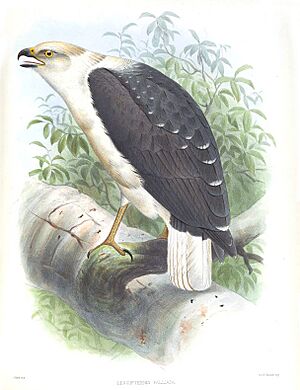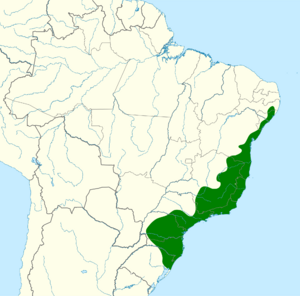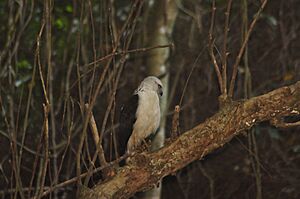Mantled hawk facts for kids
Quick facts for kids Mantled hawk |
|
|---|---|
 |
|
| Conservation status | |
| Scientific classification | |
| Genus: |
Pseudastur
|
| Species: |
polionotus
|
 |
|
| Synonyms | |
|
Leucopternis polionota (lapsus) |
|
The mantled hawk (Pseudastur polionotus) is a cool bird of prey that lives in South America. It belongs to the Accipitridae family, which includes many types of hawks, eagles, and kites.
Contents
About the Mantled Hawk
What's in a Name?
This hawk used to be called Leucopternis polionota or polionotus. But now, scientists have given it a new name, Pseudastur polionotus, based on how they classify different bird species. This process of naming and grouping living things is called taxonomy.
How to Spot a Mantled Hawk
The mantled hawk is a medium-sized bird. It looks quite strong and has broad "shoulders." It usually measures about 47 to 51 centimeters (about 18 to 20 inches) long. Female hawks are a little bigger than males.
Most of its body is white, including its head, neck, upper back, and belly. Its wingtips are black, and the bottom half of its tail is also white. Its head looks quite large compared to the rest of its body. It also has some dark marks around its eyes, making it look like it's wearing a mask!
The hawk's beak starts pale grey and turns black at the tip. Its eyes are brown, but they often look black when you see the bird in nature. Its feet and legs are orange-yellow.
Wings and Tail
The mantled hawk's wings, lower back, and rump are black or dark bluish-grey. The main flight feathers on its wings have grey bases and thin white tips. They also have a few darker bands.
When the hawk is sitting, its long wing feathers can reach or go past its tail. Its tail might look very short because other feathers cover its base.
Flying High
When a mantled hawk flies, it often glides with its wings held flat. It also soars high in the sky a lot during the day. This makes it easy to spot, even from far away, especially when it's resting on a high branch.
From below, you can mostly see the white part of its tail. Sometimes, you might see one or two dark bands near the base of its tail. This hawk looks a bit like the white-necked hawk when it flies. However, the mantled hawk has a wide white edge on its wings and tail, while the white-necked hawk has a black one.
Young Hawks
Young mantled hawks look similar to adults. But their feathers are more spotted. They have dark streaks on their white head and neck. Their upper wing feathers have whitish edges, and they have more dark bands at the base of their tail than adult hawks.
Where Mantled Hawks Live
Their Home in the Forest
The mantled hawk lives in a specific area of South America called the Atlantic Forest. This forest is found in eastern Brazil, southeast Paraguay, and the very northeast of Argentina. They might also live in northern Uruguay.
These hawks prefer humid forests, especially in foothills and at higher elevations. They can live from sea level up to at least 1500 meters (about 4,900 feet) high. They like continuous evergreen forests, but also use forest edges, natural clearings, and patches of dry trees. They can even be found in areas where some trees have been cut down, especially where Parana Pine trees grow.
Mantled hawks are most common in eastern Brazil. They are rarer in places like eastern Uruguay and southeast Paraguay. Overall, there aren't a huge number of them.
Life of a Mantled Hawk
What Do They Eat?
Like many other hawks, the mantled hawk is a "sit-and-wait" hunter. This means it rests on a perch, usually about 5 to 7 meters (16 to 23 feet) above the ground. From this spot, it has a clear view of its surroundings to find food. These hunting spots can even be in recently cleared parts of the forest.
When it spots prey, it flies quickly from its perch to catch it. Then, it returns to its perch to eat. Mantled hawks mostly eat smaller birds like tanagers, trogons, doves, and rufous-sided crake. They also eat lizards, snakes, and small rodents.
Challenges They Face
The number of mantled hawks has gone down a lot. Their forest homes are being cut down, especially because of mining for iron ore. Even though this is a problem, it's thought to be less of a threat for mantled hawks than for some other hawk species, like the white-necked hawk, because mantled hawks live in a wider range of upland areas.
In the past, farming and cutting down forests for mining caused big drops in their population. Today, new threats include cities growing, more industries, and new roads being built. However, these hawks might be able to live in areas that have a mix of pine tree farms and native forests. Scientists are still studying how well they can survive in forests that are broken up into smaller pieces. Many people believe that more protected areas are needed to save their forest homes.
Mantled Hawks and Humans
These hawks can be quite territorial when humans are around. They might try to defend their space by making loud calls or even chasing people away. When humans are nearby, mantled hawks are often very vocal. They call repeatedly, which makes them quite easy to find, even from a few kilometers away.
Conservation Status
Since 2004, the mantled hawk has been listed as Near Threatened by the IUCN (International Union for Conservation of Nature). This means their population is small and getting smaller. Experts estimate there are only about 3,500 to 15,000 mantled hawks left in the wild.



